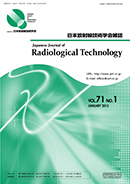All issues

Volume 71, Issue 1
Displaying 1-13 of 13 articles from this issue
- |<
- <
- 1
- >
- >|
Opening Article
-
Shigeru Sanada2015 Volume 71 Issue 1 Pages i
Published: 2015
Released on J-STAGE: January 27, 2015
JOURNAL RESTRICTED ACCESSDownload PDF (383K)
New Year Round Table Discussion
-
Takayuki Ishida, [in Japanese], [in Japanese], [in Japanese], [in Japa ...2015 Volume 71 Issue 1 Pages 1-6
Published: 2015
Released on J-STAGE: January 27, 2015
JOURNAL RESTRICTED ACCESSDownload PDF (5381K)
Originals
-
Shinichiro Hirose, Hiroaki Matsuzawa, Asako Hirose, Kiyosumi Kawamoto2015 Volume 71 Issue 1 Pages 7-11
Published: 2015
Released on J-STAGE: January 27, 2015
JOURNAL FREE ACCESSExposure index (EI) is expected as important standard for the optimization of image quality and exposed dose in digital radiography. It is set a region of interest (ROI) in a radiograph, to obtain a histogram of pixel values within an ROI, it is computed as EI of the image representative value of the histogram. In this study, we examined the effects of setting the ROI for EI computing. We set five different ROIs in chest or cervical spine frontal radiograph, and compared the computed EI in each ROIs. From the result, in some cases, we found that EI varied greatly as those compared to the case of ROI set in full image. We should consider about setting the ROI for EI computing when we use EI as standard for optimization of image quality and exposed dose in digital radiography.View full abstractDownload PDF (2763K) -
Ayaka Hirosawa, Kosuke Matsubara, Hironori Kondo, Kichiro Koshida2015 Volume 71 Issue 1 Pages 12-18
Published: 2015
Released on J-STAGE: January 27, 2015
JOURNAL FREE ACCESSThere are two types of radiophotoluminescent glass dosimeters (RPLDs). One has a tin filter in the capsule (GD-352M) and the other has no filter (GD-302M). The purpose of our study was to evaluate the properties of these RPLDs for computed tomography (CT) dosimetry: energy dependence, variation, angular dependence, and dose distribution in a single slice. Energy dependence and variation were investigated for ratio of the air kerma measured by RPLDs to that by ion chamber. Angular dependence was investigated for RPLDs and ion chamber. RPLDs were irradiated at 90°, 60°, 30°, 0°, −30°, −60°, and −90°: 0° was vertical to long axial direction of the RPLD, and plus and minus meant clockwise and anti-clockwise, respectively. Dose distribution in a single slice of an anthropomorphic phantom was acquired using 46 RPLDs. The dose responses of GD-302M and GD-352M depended on beam energy and irradiation angle of X-ray, respectively. The dose variation among dosimeters was large with GD-352M. The dose obtained from GD-352M was lower than that from GD-302M. It was expected that the dose distribution of GD-352M was formed by the primary X-ray, so RPLD without tin filter should be used for CT dosimetry.View full abstractDownload PDF (3770K)
Work in Progress
-
Masahiro Miyai, Yasushi Yamamoto, Taku Uchibe, Nobuhiro Yada, Akio Kom ...2015 Volume 71 Issue 1 Pages 19-22
Published: 2015
Released on J-STAGE: January 27, 2015
JOURNAL FREE ACCESSDiscovery NM 530c (CZT SPECT) is a new single photon emission computed tomography (SPECT) scanner using a cadmium-zinc-telluride (CZT) solid-state semiconductor detector technology. Due to multi-pinhole collimator design of this system, each CZT detector facing different direction and be able to get incidence radioactivity from radioisotopes (RIs) existing outside of effective field of view (EFOV). The purpose of this study is to verify its impact and compare it to a conventional Anger-type SPECT scanner (Discovery NM/CT 670 pro). We used 99mTcO4– as radiation source and set it outside of the EFOV at several different positions (height and angle) and scanned by both the cameras. As a result, CZT SPECT got more influence compared to Anger-type SPECT. The impact was different according to its height. When using other RIs in CZT SPECT room, it is important to confirm the appropriate position against CZT SPECT during scan.View full abstractDownload PDF (3284K)
Special Plan—Member Interview: The People Who Contributed to the Academic Society—
-
2015 Volume 71 Issue 1 Pages 25-32
Published: 2015
Released on J-STAGE: January 27, 2015
JOURNAL RESTRICTED ACCESSDownload PDF (7647K)
The 70th Annual Scientific Congress
-
Kouzou Hanai, Toru Matsumoto, Kohei Murao, Yoshihisa Muramatsu, Shiho ...2015 Volume 71 Issue 1 Pages 33-42
Published: 2015
Released on J-STAGE: January 27, 2015
JOURNAL RESTRICTED ACCESSDownload PDF (4769K) -
Minoru Hosoba2015 Volume 71 Issue 1 Pages 43-49
Published: 2015
Released on J-STAGE: January 27, 2015
JOURNAL RESTRICTED ACCESSDownload PDF (3862K)
Special Article for Vol. 70
-
Nuclear Medicine Section2015 Volume 71 Issue 1 Pages 50-59
Published: 2015
Released on J-STAGE: January 27, 2015
JOURNAL RESTRICTED ACCESSDownload PDF (619K)
Educational Lecture—Monte Carlo Simulation for Radiological Technology
-
Hitoshi Sato2015 Volume 71 Issue 1 Pages 60-65
Published: 2015
Released on J-STAGE: January 27, 2015
JOURNAL RESTRICTED ACCESSDownload PDF (2589K)
Basic Lecture—Image Reconstruction: Basic and Clinical Application
-
Keiichi Matsumoto2015 Volume 71 Issue 1 Pages 66-71
Published: 2015
Released on J-STAGE: January 27, 2015
JOURNAL RESTRICTED ACCESSDownload PDF (3876K)
Basic Lecture—Disease of the Brain: From Diagnosis to Treatment
-
Yoshiyuki Nishio, [in Japanese]2015 Volume 71 Issue 1 Pages 72-76
Published: 2015
Released on J-STAGE: January 27, 2015
JOURNAL RESTRICTED ACCESSDownload PDF (705K)
JIRA Topics
-
Takanori Iino2015 Volume 71 Issue 1 Pages 77-79
Published: 2015
Released on J-STAGE: January 27, 2015
JOURNAL RESTRICTED ACCESSDownload PDF (1609K)
- |<
- <
- 1
- >
- >|